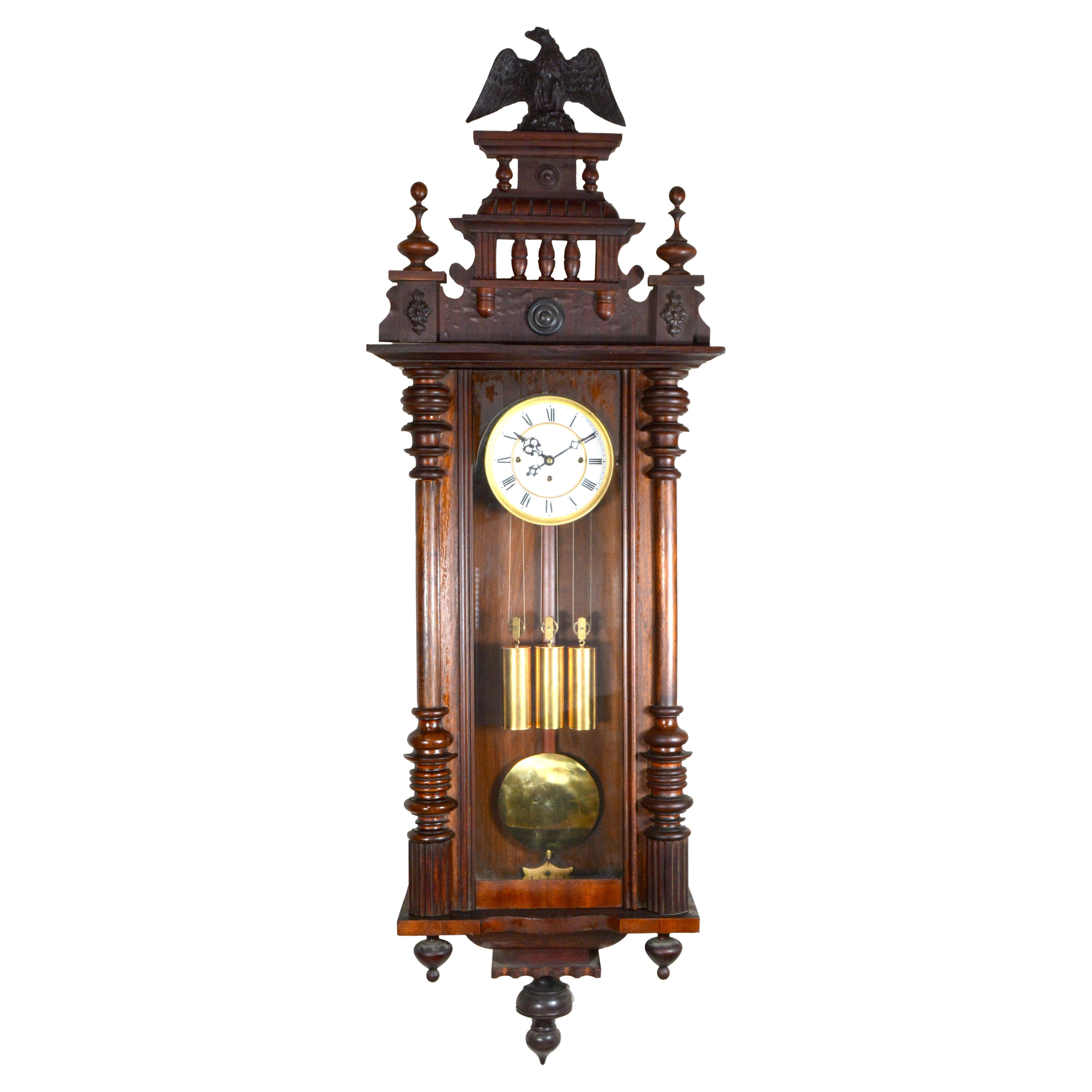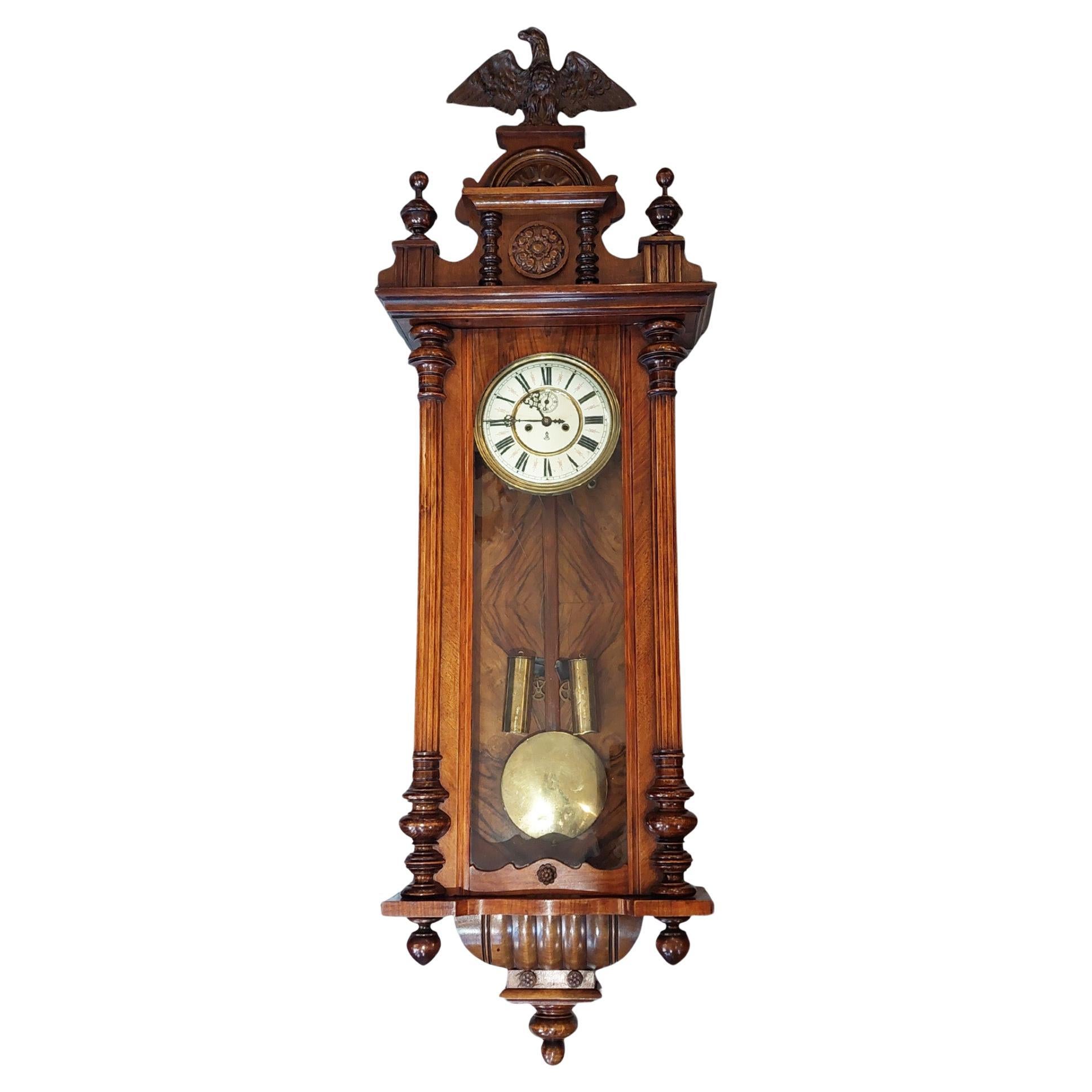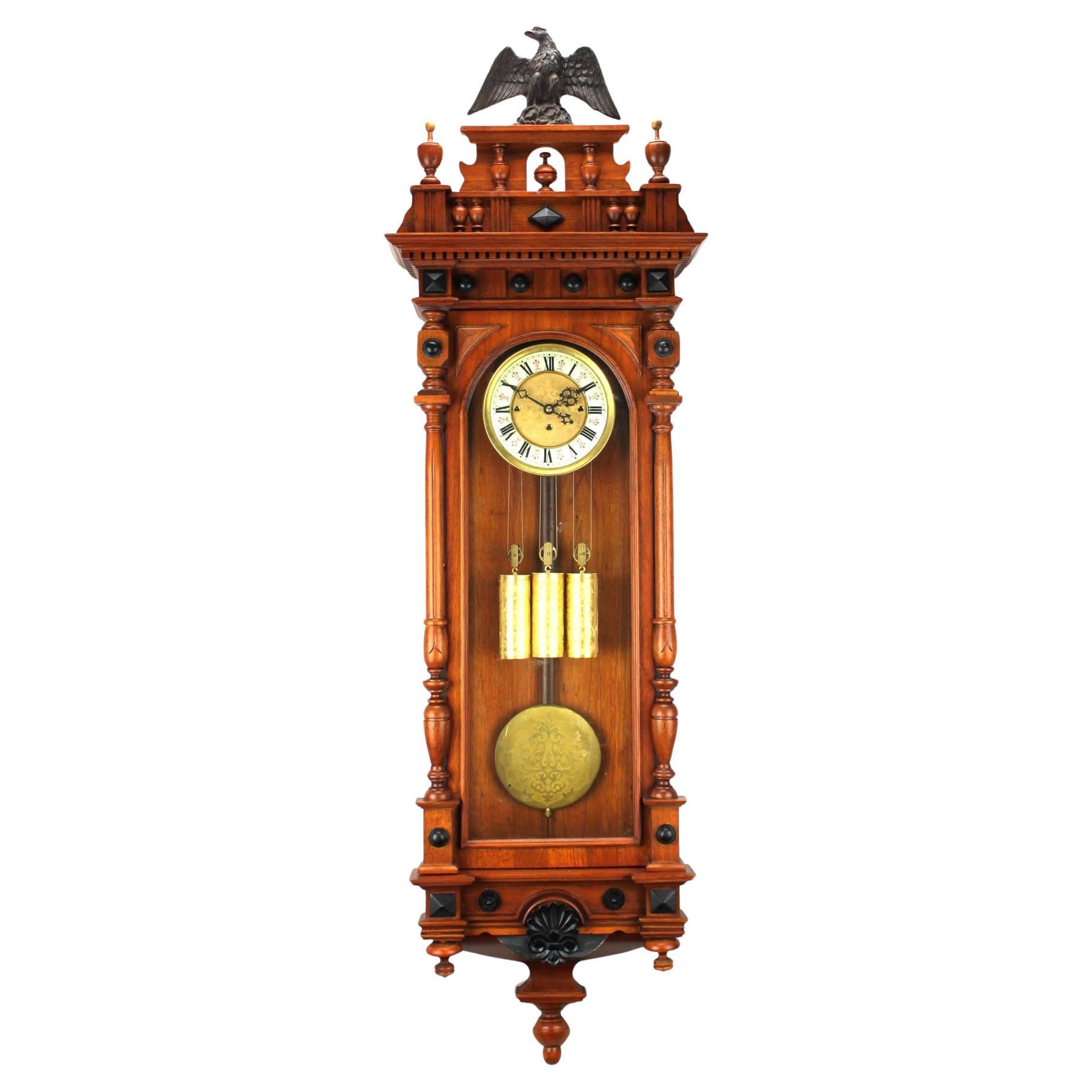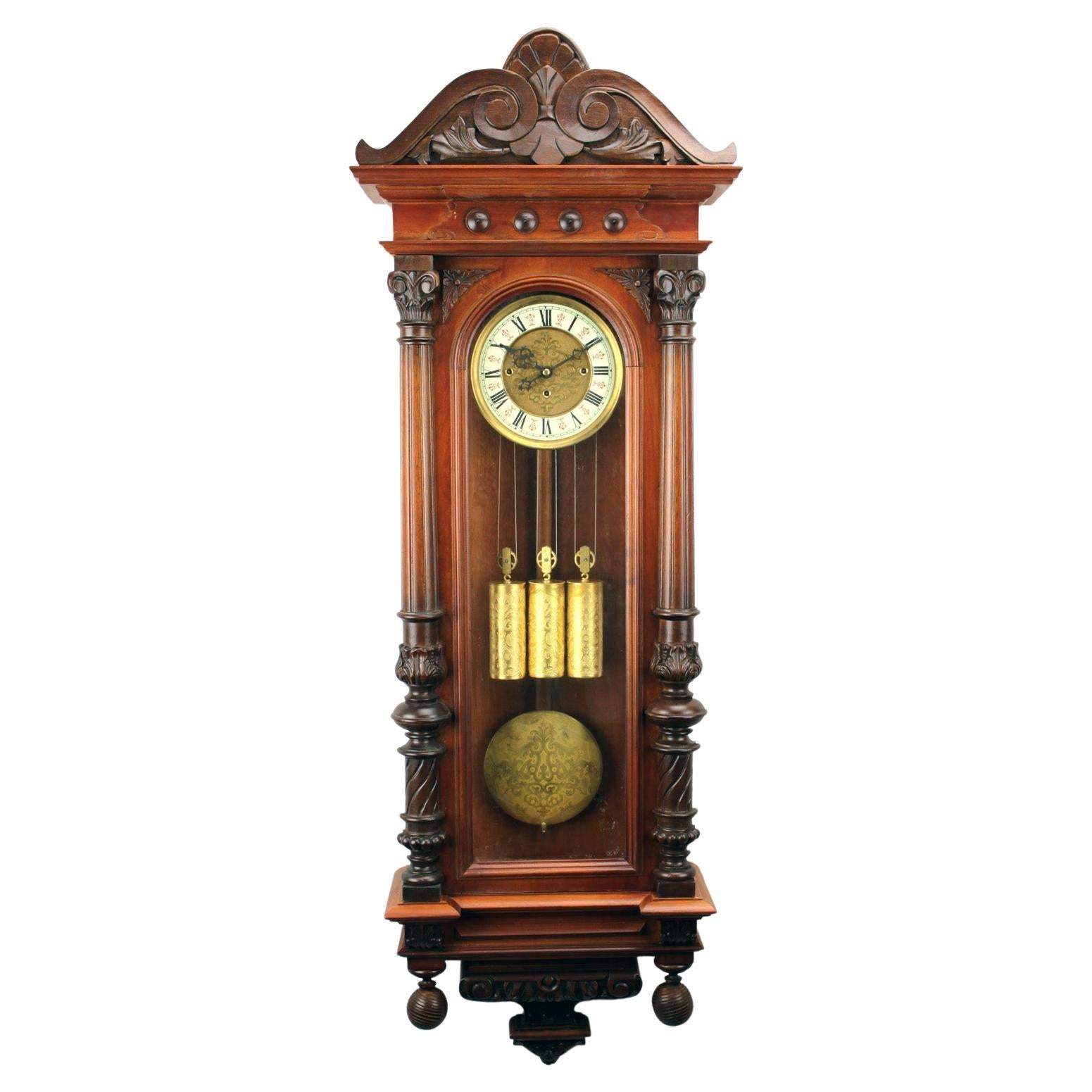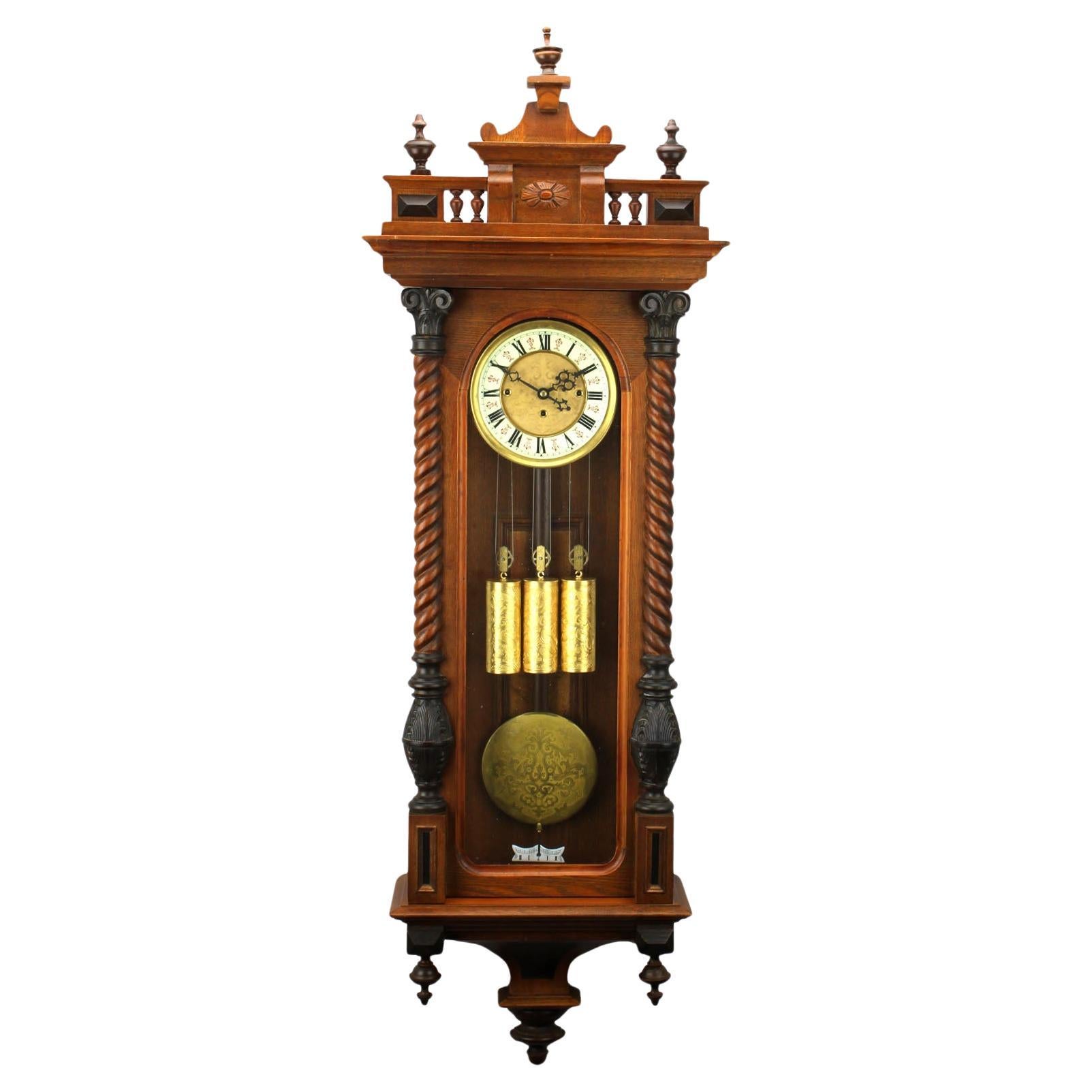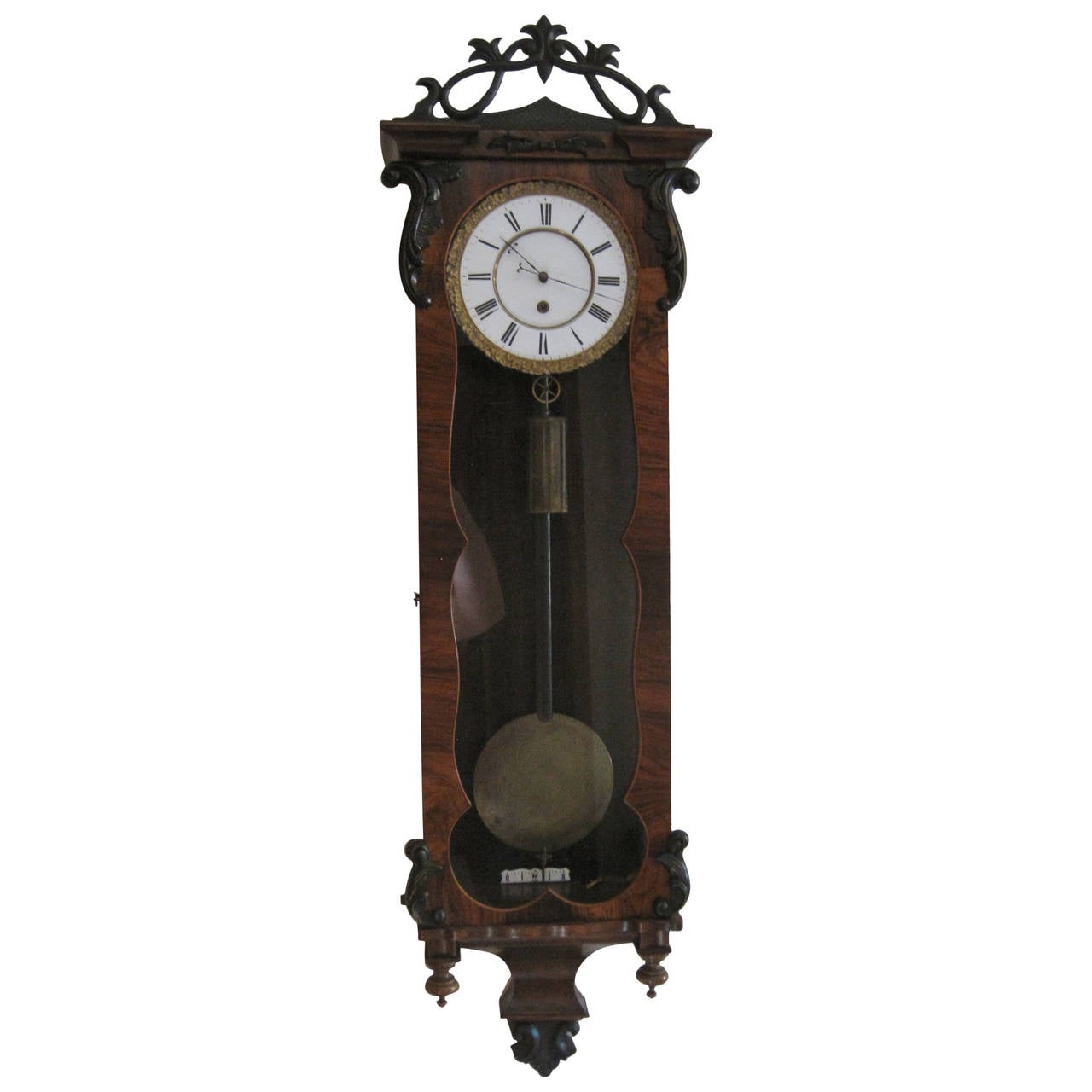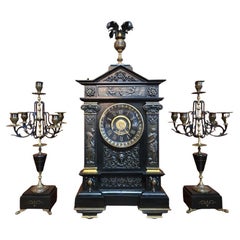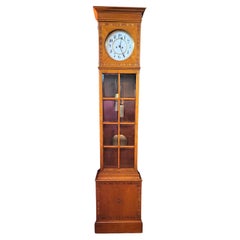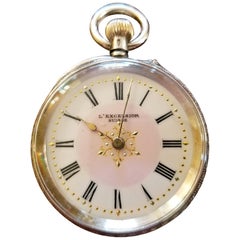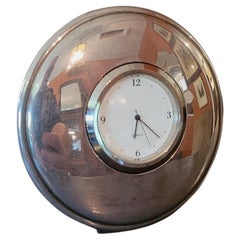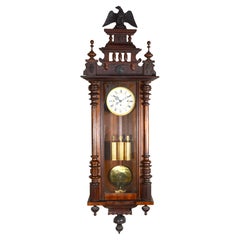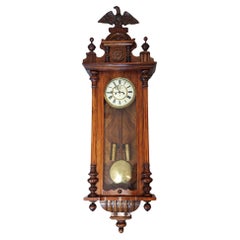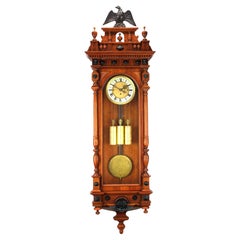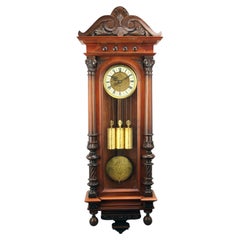Items Similar to 19C Gustav Becker Vienna Wall Clock
Video Loading
Want more images or videos?
Request additional images or videos from the seller
1 of 22
19C Gustav Becker Vienna Wall Clock
$4,000
£3,026.27
€3,492.79
CA$5,586.89
A$6,211.55
CHF 3,251.37
MX$76,182.62
NOK 41,398.19
SEK 39,084.80
DKK 26,064.35
Shipping
Retrieving quote...The 1stDibs Promise:
Authenticity Guarantee,
Money-Back Guarantee,
24-Hour Cancellation
About the Item
PRESENTING A GORGEOUS 19C Gustav Becker Vienna Wall Clock.
Made by the famous clockmaker, Gustav Becker circa 1880 in Germany.
The Clock, is in good original and untouched condition.
The removeable pelmet has an eagle on top which is marked on the rear as being made by Gustav Steinert of Freiburg SCHL (Germany) as is marked ‘No 288’ Geschulzt.
From our research Gustav Steinert was a supplier of Clock moldings and carved adornments established in Germany in 1877.
Beneath the eagle is a pelmet/crown with central rosette and turned finials with a pair of turned acorn finials on either side.
The clock case has a large glassed door that opens sideways. It has a pair of turned and fluted side columns again with a rosette in the center.
The clock face is porcelain, encased in brass with roman numerals and hand painted red fleur de lis. It contains an inner dial for the second hand movement.
The clock face is properly marked for Gustav Becker having the “GB” under crown and anchor symbol.
It has 2 winding holes (with original keys) for time and chime/strike.
The clock does not have a chime but sounds off or strikes on the hour and half hour.
It has its original brass pendulum and porcelain insert at the bottom to indicate the movement of the pendulum.
It has its original lead (brass encased) lead weights.
There are 2 serial numbers on the rear of the clock movement (see attached pics).
The Clock also has 2 stamps/seals. The stamps/seals confirm: (1) the maker – “Gustav Becker” with, Anchor with crown and initials “GB”, “Freiburg In Seal” and (2) “Medaille D’Or with Celtic Cross symbol.
The 2 numbers are “P64/722836.
Each lead (encased in brass) weight is just over 3 lbs/1.4 Kg.
The clock appears to have all it’s working parts, but needs a professional servicing and we would also suggest professional installation, to have it fully working and operational. This will not be expensive and any time a clock like this is moved or shipped it always requires this, in any event.
Gustav Eduard Becker (May 2, 1819 in Oels, Silesia – September 17, 1885 in Berchtesgaden) was a German clockmaker and founder of the brand Gustav Becker.
Becker learned clockmaking in Silesia and enriched his skills by learning from many masters around Germany which, during that era, was the most important country in the clock industry. His great skills gave him the ability to fix clocks at the most intricate level. During his time in Vienna, he decided to start his own clock factory.
Becker came back to Silesia in 1845, and got married. In 1847, he settled in Freiburg, Lower Silesia (now Swiebodzice, Poland), and that April he opened a small clock shop with a few employees to whom he taught clockmaking. First, he created clocks in the Viennese model, and thanks to his success, in 1850 he moved his business to a better business centre.
His breakthrough came in 1852 at the Silesian Clock Fair. Crowds were drawn to his works because of the quality, and he was awarded the gold medal for the best clock in the fair. In 1854 he received large orders from the British Royal Mail, and the Silesian Telegraphy Centre. After the orders, he received a fortune from the Duke of Martibore, and with this money he could pay enough to make clock cases for train stations. In the 1860s, he began to create the Classical Gustav Becker clocks. Starting from fairly simple clocks, the clocks became complex and very ornamental, and sales rose to a peak in 1875, with over 300,000 clock orders. He won at clock fairs in London, Paris, Sydney, Melbourne, Berlin and Amsterdam.
During the 1880s, the Black Forest clockmakers began competing with Becker, with good quality, less-expensive models. A well-known type of Black Forest clock is the Cuckoo clock. With the decline of sales, Becker stopped selling complex clocks, and returned to making more simple designs.
Gustav Becker died on 14 September 1885 in Berchtesgaden during a stay in Bavaria. He was buried three days later in a municipal cemetery in Freiburg (now Swiebodzice) to much public mourning.
- Creator:Gustav Becker (Clockmaker)
- Dimensions:Height: 51 in (129.54 cm)Width: 18.5 in (46.99 cm)Depth: 7 in (17.78 cm)
- Style:Victorian (Of the Period)
- Materials and Techniques:
- Place of Origin:
- Period:
- Date of Manufacture:1880
- Condition:Wear consistent with age and use. Minor losses. Minor structural damages. Minor fading. Good original condition. Untouched. May be missing a pair of finials on the base. Some very minor ‘crazing’ to the wood varnish. Needs a professional servicing to have fully operational.
- Seller Location:Dallas, TX
- Reference Number:1stDibs: LU3978123157452
About the Seller
4.9
Vetted Professional Seller
Every seller passes strict standards for authenticity and reliability
Established in 2015
1stDibs seller since 2018
390 sales on 1stDibs
Typical response time: 2 hours
- ShippingRetrieving quote...Shipping from: Dallas, TX
- Return Policy
Authenticity Guarantee
In the unlikely event there’s an issue with an item’s authenticity, contact us within 1 year for a full refund. DetailsMoney-Back Guarantee
If your item is not as described, is damaged in transit, or does not arrive, contact us within 7 days for a full refund. Details24-Hour Cancellation
You have a 24-hour grace period in which to reconsider your purchase, with no questions asked.Vetted Professional Sellers
Our world-class sellers must adhere to strict standards for service and quality, maintaining the integrity of our listings.Price-Match Guarantee
If you find that a seller listed the same item for a lower price elsewhere, we’ll match it.Trusted Global Delivery
Our best-in-class carrier network provides specialized shipping options worldwide, including custom delivery.More From This Seller
View All19C French Mantle Clock with Candelabra Garnitures by J. Marti (Paris)
By Marti
Located in Dallas, TX
PRESENTING A STUNNING Mid 19th Century French Slate & Bronze Mantel Clock by Marti with pair of slate and bronze candelabra’s as garnitures.
This ‘large’ mantle clock, was made circ...
Category
Antique Mid-19th Century French Neoclassical Revival Mantel Clocks
Materials
Slate, Brass, Bronze
Art Deco Portois and Fix Viennese Tall Case Clock
By Portois & Fix
Located in Dallas, TX
Presenting an amazingly rare piece of Art Deco furniture by an exceptionally rare maker, namely, an Art Deco Portois and Fix Viennese Tall Case Clock.
...
Category
Early 20th Century Austrian Art Deco Grandfather Clocks and Longcase Clocks
Materials
Brass
19th Century Swiss Ladies L Excelsior Silver Pocket Watch
Located in Dallas, TX
Gorgeous little solid silver Swiss ladies pocket watch from 1880.
L'Excelsior Suisse
White and pink enameled face with gorgeous silver repousse work on rear with unmarked armor...
Category
Antique Late 19th Century Swiss Late Victorian More Clocks
Materials
Silver
Art Deco Style Chrome or Silveroid Desk Timepiece
Located in Dallas, TX
Presenting a lovely Art Deco style chrome or silveroid desk timepiece.
Probably made circa 1980.
The case is a solid circular shaped chrome or sil...
Category
20th Century American Art Deco More Clocks
Materials
Silver Plate, Chrome
French 19C Japy Freres & Red Sevres Porcelain Mantle Clock with Garniture Set
By Phillipe Mourey, Japy Frères, Manufacture Nationale de Sèvres
Located in Dallas, TX
PRESENTING A STUNNING mid to late 19C French Japy Freres & Red/Magenta Sevres Porcelain Mantle Clock with Garniture Candlestick Ewers.
The clock movement is by the famous Parisienne Clockmaker … ‘Japy Freres’ and the clock dial has the marks for “JAY” (short for Japy Freres) & “Paris” on the dial face.
The clock mechanism and clock face/dial have matching serial numbers of “7225”. The movement also has the numbers: “5 – 2”.
The clock face/dial also has the initials: “D.H.”.
The gilt ormolu clock case is gilt spelter and is signed on the rear base, for having been made by “P.H. Mourey” of Paris, who worked with and for ‘Japy Freres’, towards the end of the 19th Century.
The signature of ‘Mourey’ also bears the numbers “85” … probably for 1885, but could also be the serial number.
Taking into account Mourey’s historical association with Japy, being late 19th Century, we are leaning heavily towards this being the date of manufacture i.e. 1885.
The Clock has RARE red/magenta Sevres hand-painted porcelain paintings/additions, to include:-
(i) a 2 handled and lidded urn on the crown with pointed flame finial,
(ii) a pair of bulbous urns either side of the main body and clock face,
(iii) the clock face and dial itself and
(iv) a flat rectangular medallion on the front base.
The crown urn and the base medallion both have similar themes, but different painted scenes, depicting French rural countryside scenes with cottages, rivers and bridges.
The porcelain urns on the sides, likewise have hand-painted images of a young boy, in rustic period attire on the right and a young girl on the left.
None of these paintings appear to be signed.
The clock case has GLORIOUS detail to it, with scrolls, ribbons, vines, grapes and Corinthian columns.
The clock sits on a custom made gilt wood and burgundy velvet plinth, that is original to the piece and was a common accent with ‘Japy Freres Clocks’, when originally retailed in their Paris shop.
The rear of the clock is plain and the perspex/clear resin plate insert, is a new addition, but a nice addition, in that it allows one, to view the movement and pendulum works.
The clock is an 8 day movement with a strike on the hour and half hour. The clock face has 2 winding holes … one for the pendulum movement and the other for the striking chime/ring.
Unlike British clocks this clock does not have a long musical chime … it is a simple ‘single strike’ on the half hour.
The red/magenta Sevres porcelain clock face/dial is in SUPERB condition. Roman numerals with gilt accents and a hand-painted circular wreath/bouquet of spring flowers on the center section.
To complete the set, we have a matching pair of gilt ormolu spelter and hand-painted red/magenta Sevres porcelain Ewers … which can hold a single candle each.
The porcelain urns on the central section, have hand-painted images of a young lady in rustic period attire … fishing on the riverbank on the right and a young man playing the flute in the countryside on the left.
The front base medallions on each ewer have hand-painted wreaths/bouquets of spring flowers.
The clock facing side of the porcelain urn on each Ewer, has a brass ormolu applique head, of the Greek god of wine-making, orchards and fruit, vegetation, fertility, festivity, insanity, ritual madness, religious ecstasy, and theatre, namely, Dionysus.
The plinths are signed on the rear top left corner, and we think they read: “R.P. Unfaut”. They also bear the numbers “61” and “69”, Again, possibly for 1861 and 1869, but here we think it is more likely they are serial numbers, as it is highly unlikely that a matching pair were made 8 years apart!
Whilst we cannot find any information on ‘R.P. Unfaut’, we can only guess that he/she/they worked with, or for, ‘Japy Freres’, as these ewers are unmistakably, a ‘superb’ match for the clock!
The style, subject matter, gold banding and edging, around the paintings, are virtually ‘identical’ to the same decorations on the clock’s porcelain paintings.
The Ewer on the left (with the boy playing the flute) appears to have a faded signature on the gold border of the painting towards the base and we think it is the signature of ‘Alexandre Evariste Fragonard’ …. one of the best known artists attached to Sevres in the mid 19th Century … meaning, that these Ewers were probably made circa 1845-50.
The quality and detail to these 2 paintings is classic Fragonard!
We are of the opinion, therefore that these garnitures, were made circa 35/40 years before the clock, as Mourey was prevalent with Japy around 1880 – 1900.
The clock paintings are of a very similar, rustic ‘Fragonard Style’ subject matter and although unsigned, could possibly have been painted by a Sevres artist, to replicate the Fragonard paintings...
Category
Antique 19th Century French Rococo Revival Mantel Clocks
Materials
Ormolu
Large 19 Century French Rococo or Neoclassical Revival Style Vitrine
By David Roentgen
Located in Dallas, TX
Stunning 19th century French Empire, neoclassical/Rococo Revival style Marquetry vitrine or display cabinet, of large proportions!!
A real statement piece!
Made of a fabulous variety of veneers, including kingwood, satinwood, tulipwood, harewood and walnut with quality classical ormolu mounts.
It has ebonized pillars in the Empire style, with walnut and exotic hardwood friezes in the Rococo style.
Double glass doors to middle section and single glass doors on either side.
The glass on the doors are framed in ormolu banding.
Floral Marquetry panels on front and parquetry on the sides.
The front central section is a pullout / pull-out drawers with gorgeous walnut frieze panel and original carved walnut knobs.
Scrolling pelmet on the top in 3 sections banded in ormolu beading.
Scrolling base with cabriolet feet and ormolu mounts on base.
Various ormolu mounts, floral mounts, mounts of Baachus and mounts of neoclassical female figures.
In 3 sections. with 2 side cabinets and large central section with 3 section pelmet, stunning piece!!!
The quality ormolu mounts are marked with the letter “R” and what appears to be “FR 678”.
We were originally of the belief that this piece might have been made at the very end of the 19th century, but having regard to the quality of workmanship throughout this piece we are of the opinion that it was most likely made in the third quarter of the 19th century, circa 1870 and by an obviously top quality Parisienne maker with a surname beginning with “R”.
It is definitely in the style of David Roentgen who was known for his Rococo/neoclassical styles.
David Roentgen, (born Aug. 11, 1743-died Feb. 12, 1807, Wiesbaden, Duchy of Nassau), cabinetmaker to Queen Marie-Antoinette of France; under his direction the family workshop at Neuwied (near Cologne), founded by his father, Abraham Roentgen, became perhaps the most-successful firm of furniture production in the 18th century.
After succeeding his father as head of the Neuwied workshop in 1772, Roentgen strove to broaden their clientele, an ambition that brought him first to Hamburg and ultimately to Paris (1774), where in 1779 he was spectacularly successful in selling his finest furniture to King Louis XVI of France for £3,300 to £4,000, an unprecedented sum for the time.
Appointed cabinetmaker to the queen, Roentgen was granted admission (1780) as maître-ébéniste (master cabinetmaker) to the trade corporation of Paris cabinetmakers, making it possible for him to keep in Paris a stock of the furniture manufactured at Neuwied. Thus he was able to compete with such great cabinetmakers as Jean-Henri Riesener and Adam Weisweiler, reputedly his former pupil at Neuwied. After his first visit to St. Petersburg, Empress Catherine II the Great bought huge quantities of his furniture; King Frederick William II of Prussia was also his client. When in 1795 the French Revolutionary armies threatened to cross the Rhine, Roentgen evacuated his establishment and moved his stock farther inland. Unfortunately, he lost everything in his Parisian salon and in his Neuwied workshop, both of which were sacked by Republican troops. He was crushed, despite his appointment as court furnisher to the king of Prussia. Although he never succeeded in starting production again, former apprentices of his whom he helped to establish in the German cities of Berlin (David Hacker...
Category
Antique Mid-19th Century French Rococo Revival Vitrines
Materials
Ormolu
$9,600 Sale Price
48% Off
You May Also Like
58" Antique 1890 German Gustav Becker Grand Sonnerie Vienna Regulator Wall Clock
Located in Danville, CA
58" Antique 1890 German Gustav Becker Grand Sonnerie Vienna Regulator Wall Clock
Here is an excellent 3 weight driven regulator wall clock. This clock is 58" tall and 19" wide. It f...
Category
Antique Late 19th Century German Wall Clocks
Materials
Brass
Late Victorian Double Weight "Vienna" Wall Clock
Located in Altrincham, GB
Late Victorian Double Weight "Vienna" Wall Clock of Architectural Form Having Carved Eagle Pediment - by Charles Greville & Co of Hatton Gardens, London with full technical drawings ...
Category
Antique 1890s English Late Victorian Wall Clocks
Materials
Walnut
German Gustav Becker 3 Weight Grand Sonnerie Vienna Regulator Wall Clock
Located in Danville, CA
Here is an excellent 3 weight driven regulator wall clock. This clock is 57-1/2" tall and 16-3/8" wide. It features a solid brass movement and chimes every 15 minutes, which are driv...
Category
Antique Late 19th Century German Wall Clocks
Materials
Brass
German Gustav Becker 3 Weight Grand Sonnerie Vienna Regulator Wall Clock
Located in Danville, CA
Highly Carved German 3 Weight Grand Sonnerie Quarter Strike Vienna Regulator Wall Clock
Here is an excellent 3 weight driven regulator wall clock. This clock is 52-1/4" tall and 17-3/8" wide. It features a solid brass movement and chimes every 15 minutes, which are driven by three engraved weights. This clock has Grand Sonnerie striking...
Category
Antique Late 19th Century German Wall Clocks
Materials
Brass
German Gustav Becker 3 Weight Grand Sonnerie Strike Vienna Regulator Wall Clock
Located in Danville, CA
German Gustav Becker 3 Weight Grand Sonnerie Quarter Strike Vienna Regulator Wall Clock
Here is an excellent 3 weight driven regulator wall clock. This clock is 52-1/4" tall and 17-...
Category
Antique Late 19th Century German Wall Clocks
Materials
Brass
Vienna Regulator Wall Clock, 19th Century
Located in Hamilton, Ontario
19th century Vienna Regulator wall clock.
One weight Vienna Regulator with ornate carved head piece.
Category
Antique 19th Century Wall Clocks
More Ways To Browse
Small Clock
Antique Wall Crosses
Crown Clock
German Medal
Antique Lead Weights
Vienna 1880
Red Antique Clock
Antique Clock Crown Clocks
Antique Clock Door Glass
Very Large Antique Clock
Antique Porcelain Fairings
London Brass Clocks
Anchor Clocks
Paris Porcelain Clock
Flute Clock
Antique Master Clock
German Eagle
Small Pendulum Clocks
